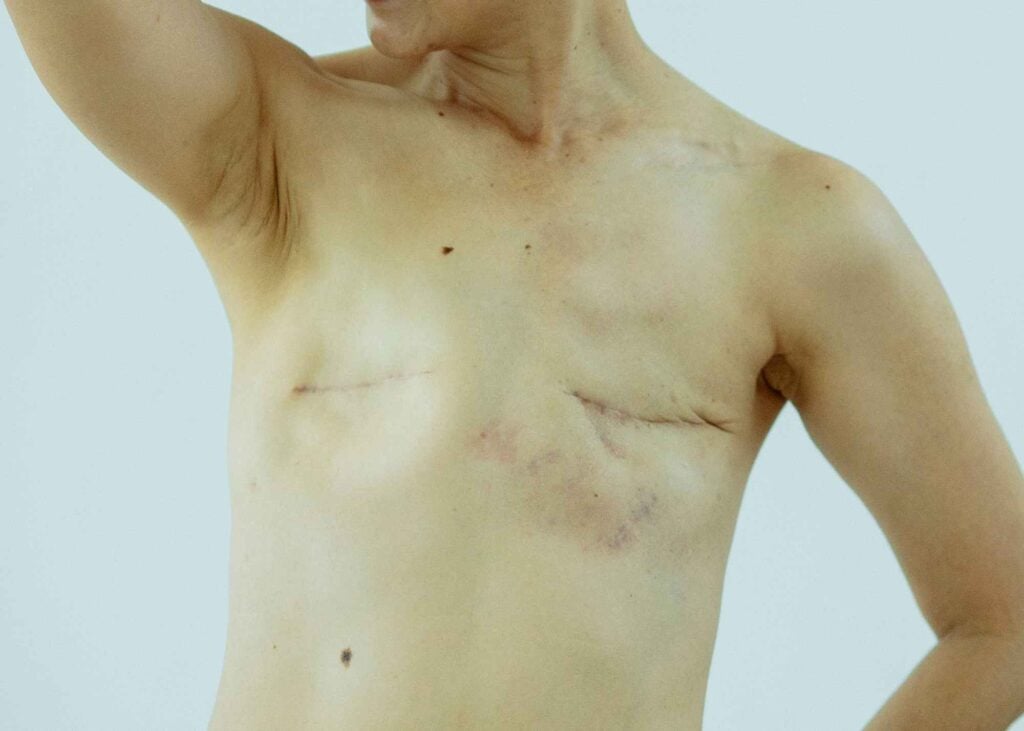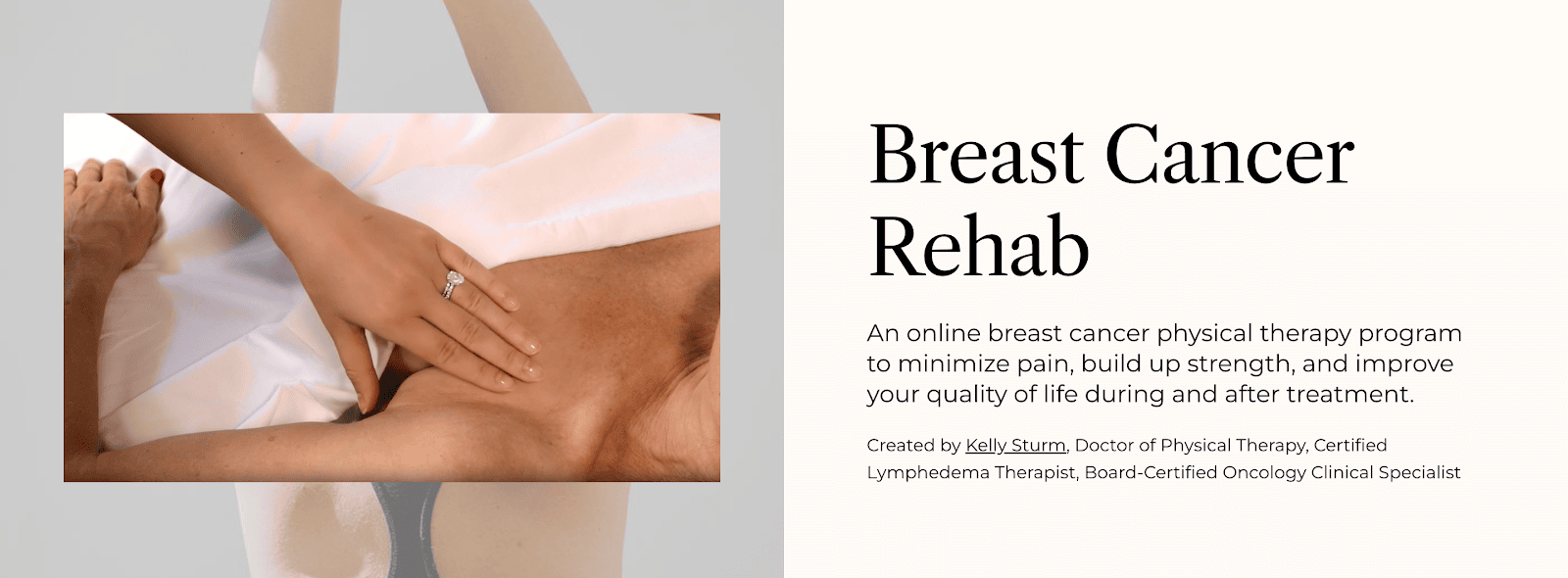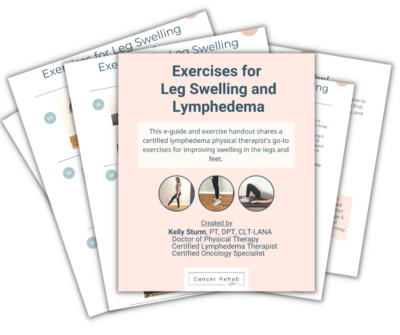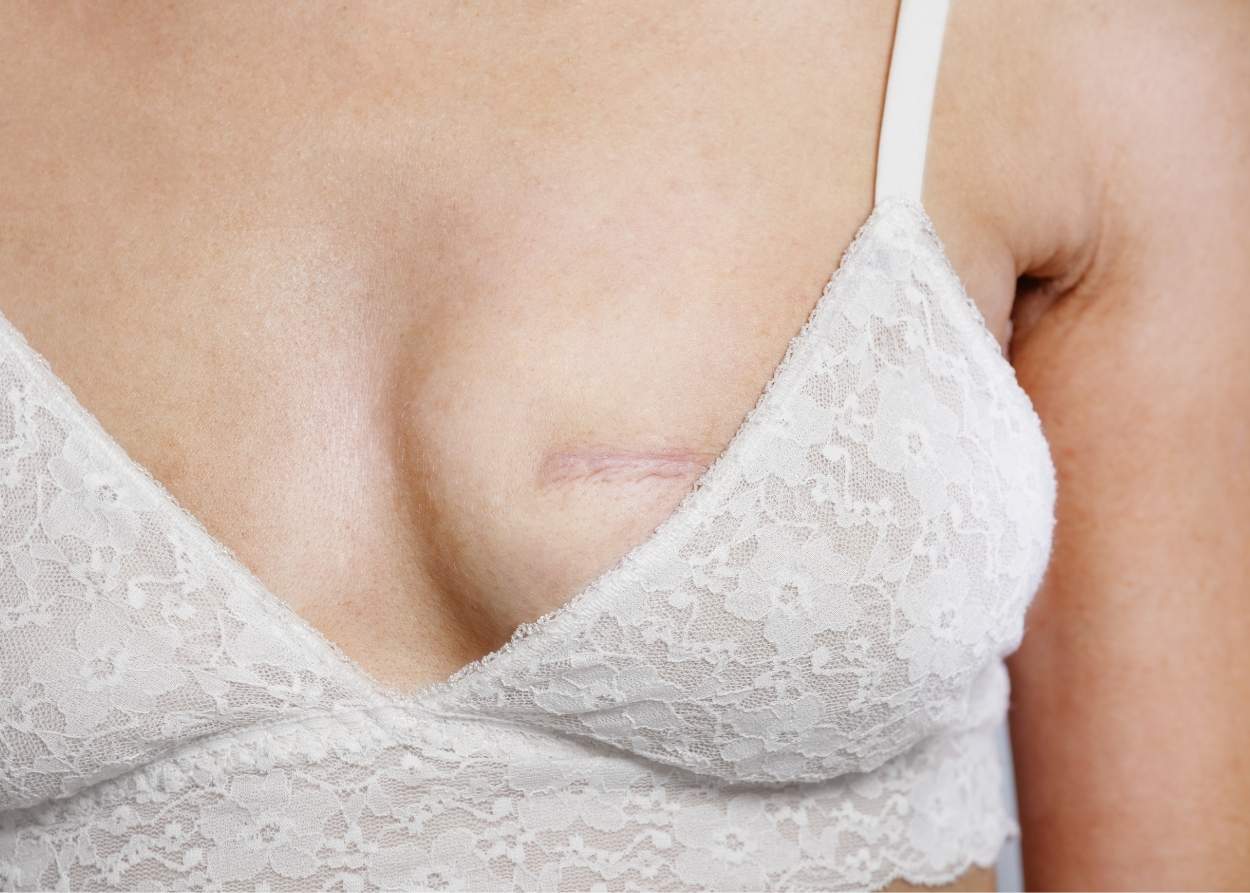Being diagnosed with breast cancer brings many decisions, and one of the most important is choosing your surgical treatment. Sometimes, you may be able to choose between having a lumpectomy (breast-conserving surgery) and a mastectomy (total breast removal).
Both surgeries are highly effective treatments, but should you get a lumpectomy vs mastectomy?
For early-stage breast cancer, both surgeries offer the same survival rates. About 75% of women diagnosed with breast cancer can choose between these two options, but 25% will need a mastectomy for medical reasons. Here’s everything else you need to know.
What Is a Lumpectomy?
A lumpectomy is a breast-conserving surgery. It removes the cancerous tumor, along with a little bit of healthy tissue around the tumor, but preserves most of your natural breast tissue and appearance. It doesn’t remove the entire breast.
Lumpectomy almost always requires radiation therapy after. Usually, you’ll need daily radiation treatments for 2 to 6 weeks to eliminate any remaining cancer cells in the breast tissue. Many women prefer to have a lumpectomy because it’s less invasive.
What Is a Mastectomy?
A mastectomy removes the entire breast, including all breast tissue, the nipple, and the areola. It’s an invasive surgery that has a longer recovery period than a lumpectomy.
There are different types of mastectomy. A total mastectomy removes all breast tissue but preserves the chest muscle underneath. Some women choose a bilateral mastectomy, which removes both breasts, even when cancer affects only one side.
You can also choose to do a breast reconstruction, which can be performed during the same surgery or at a later time.
Unlike a lumpectomy, a mastectomy may not require radiation therapy treatment, though some women will still undergo it depending on factors like lymph node involvement and tumor size.
When to Do Lumpectomy vs. Mastectomy?
The choice between a lumpectomy and a mastectomy depends on medical factors and your personal preferences. Your surgeon should let you know if you’re medically eligible for both options.
Board-certified breast surgeons typically evaluate multiple factors, including tumor characteristics, breast imaging results, and genetic testing, when determining who is appropriate for surgery.
According to BreastCancer.Org, a lumpectomy plus radiation therapy is a good option for women with cancer in only one site and a tumor under 4 centimeters.
However, your surgeon may have a different recommendation depending on your breast cancer diagnosis and history. There are also personal factors to consider, such as:
- How important is keeping your natural breast to you? Some women feel strongly about breast preservation and choose lumpectomy despite the need for radiation. Others want to remove the entire breast, or even both of them.
- How do you feel about needing daily radiation therapy? Lumpectomy often means committing to 2 to 6 weeks of weekday treatments. This can be challenging, especially if you live far away from the radiation center. That said, mastectomy sometimes requires radiation therapy, too.
- Will you constantly worry about the cancer returning? Some women find peace knowing the entire breast is gone. However, keep in mind that the chance of breast cancer recurrence after a mastectomy is still not zero.
Medical research shows that survival rates with lumpectomy plus radiation are the same as with mastectomy, so both surgery options are effective for beating breast cancer long-term.
However, there’s a difference in the risk of local recurrence, which is when the cancer returns to the same breast area. Lumpectomy has a slightly higher local recurrence rate (about 10-15% over time) compared to mastectomy (1-3%).
Also, both surgeries increase your risk of developing lymphedema, a condition that causes chronic swelling, if you have a sentinel lymph node biopsy or an axillary lymph node dissection.
Lumpectomy vs. Mastectomy: Pros and Cons
What are the pros of a lumpectomy?
The biggest advantage of lumpectomy is that you keep most of your natural breast.
Your breast will look and feel similar to how it did before surgery, though there may be some minor changes in size or shape depending on how much tissue needs to be removed.
Lumpectomy is also less invasive than mastectomy.
You’ll typically go home the same day or after one night in the hospital, and the recovery time is shorter and easier. The surgery itself is quicker, and you won’t need major reconstructive surgery.
Many women also feel that keeping their breast helps them maintain their sense of identity and body image after cancer treatment.
What are the cons of a lumpectomy?
The main downside is that you’ll most likely need radiation therapy.
This means 2 to 6 weeks of daily weekday treatments at a radiation center. It can be challenging both physically and emotionally, especially if you live far from the treatment center or have work and family responsibilities.
Lumpectomy also carries a slightly higher risk of local recurrence.
There’s about a 10-15% chance over time that cancer could return in the same breast, compared to 1-3% after mastectomy. While this sounds concerning, local recurrence can be successfully treated and doesn’t usually affect your overall survival.
Another consideration is that your breast can’t safely receive radiation again if the cancer returns to the same area later. If you develop a new cancer in the same breast, your doctor will likely recommend mastectomy since re-radiation isn’t an option.
What are the pros of a mastectomy?
For many women, the biggest advantage of a mastectomy is peace of mind.
Removing the entire breast significantly reduces the chance of cancer returning in that area. While it’s still not zero, it drops to just 1-3% compared to 10-15% with lumpectomy.
You may be able to avoid radiation therapy entirely. While some women still need radiation after mastectomy (depending on factors like lymph node involvement), many don’t.
This eliminates the need for daily radiation appointments and the side effects that come with radiation treatment.
What are the cons of a mastectomy?
Mastectomy is an extensive surgery with a much longer and difficult recovery than lumpectomy.
You’ll typically stay in the hospital for 1-2 nights and need several weeks to fully heal. The surgery takes longer and carries higher risks for complications like infection, bleeding, and poor wound healing.
The most significant downside is the permanent loss of your natural breast.
This affects how you look and feel, and may impact your body image and intimacy. You’ll also likely lose all sensation in the chest area, which doesn’t return even with reconstruction.
There are a handful of surgeons in the US who are now performing nerve-sparing mastectomy procedures. This surgical technique helps preserve the nerves to minimize the loss of sensation in the breast and nipple area.
Plus, even with modern techniques, reconstruction often requires multiple procedures and comes with its risks.

Mastectomy vs. Lumpectomy: Recurrence Rates
Your chances of surviving are the same whether you choose lumpectomy or mastectomy. Long-term, your chances of recurrence are not higher if you choose a more conservative lumpectomy, especially for early breast cancer.
However, there is a difference in local recurrence, which is cancer coming back in the same breast area. Mastectomy has a 1-3% local recurrence rate, and a lumpectomy plus radiation has a 10-15% rate.
It’s also important to note that these percentages may differ based on the type of tumor or stage that an individual is diagnosed with.
Local recurrence doesn’t affect your survival.
If cancer returns after lumpectomy, doctors can treat it successfully with mastectomy and other breast cancer treatments.
The risk of cancer spreading to other parts of your body is the same with both surgeries. Your cancer’s biology, size, and other characteristics matter much more than which surgery you choose.
Most women who have undergone either breast surgery never experience any cancer recurrence.
Partial Mastectomy vs. Lumpectomy
A partial mastectomy and lumpectomy are essentially the same procedure. Both surgeries remove the tumor and some surrounding normal breast tissue while preserving most of your breast.
You might hear your breast surgeon use these terms interchangeably, or they might also call it “breast-conserving surgery,” “breast-conserving therapy,” or “wide local excision.”
Breast Reconstruction After a Mastectomy
Breast reconstruction rebuilds the shape of your breast after mastectomy using either implants or healthy tissue from other parts of your body.
You can have reconstruction during the same surgery as your mastectomy (immediate reconstruction) or wait until after you’ve completed other treatments (delayed reconstruction).
Implant reconstruction uses saline or silicone implants to create the new breast. This is usually a simpler procedure, but implants may need replacement every 10-15 years.
Tissue reconstruction uses muscle, fat, and skin from another part of your body, such as your abdomen, back, or thigh. This creates a more natural-feeling breast, but the surgery is more complex, and recovery takes longer.
These surgeries do differ based on each individual, so it’s important to discuss with a board-certified plastic surgeon who specializes in breast reconstruction to learn what your options are.
Reconstruction isn’t required, and some women choose not to have it. You can use external breast forms (prosthetics) instead, or simply go flat.

Is It Better to Have a Lumpectomy or a Mastectomy?
Neither surgery is “better” than the other. Both a lumpectomy and a mastectomy are effective treatments with a low risk of recurrence. About 75% of women can choose between the two options, but 25% will need a mastectomy for medical reasons.
You might choose a lumpectomy if:
- You want to keep your natural breast
- You’re comfortable with 2 to 6 weeks of daily radiation treatments
- You live close to a radiation center, or can manage the daily trips
- You’re okay with slightly higher local recurrence risk (10-15% vs 1-3%)
- You prefer shorter surgery and faster recovery
- You don’t have genetic mutations that increase cancer risk
Breast conservation is very important to some women, and it’s easier to recover after a lumpectomy, which makes it the preferred option for many women.
However, you might choose a mastectomy if:
- You want to remove the entire breast
- You want to avoid radiation therapy if possible
- You’re concerned about ongoing mammogram anxiety
- You have genetic mutations like BRCA1 or BRCA2
- You’re young with many decades of future cancer risk
- You live far from radiation facilities
- You have multiple tumors or large tumors relative to breast size
When both options are medically appropriate, the choice between a total mastectomy versus lumpectomy is entirely yours.
Sometimes, your surgeon’s training and experience may influence which options they present to you. BreastCancer.Org warns that surgeons who trained before the mid-1980s might lean more toward mastectomy since that was the standard treatment for all breast cancers at the time.
If you feel strongly about one option over another, ask your surgeon about their experience with both procedures and why they recommend one approach.
Don’t be afraid to ask questions. I also find it most helpful to get a second opinion (or more) before making a final decision.
Recovering After Breast Cancer Surgery
Regardless of which surgery you choose, physical therapy can make a big difference in your recovery. Many women don’t realize that specialized physical therapy is available after breast cancer surgery to help prevent complications and support rehabilitation.
Physical therapy can help with:
- Restoring full shoulder and arm movement after surgery
- Muscle weakness
- Softening scar tissue
- Pain and discomfort
- Swelling after surgery
- Fatigue management
- Cording
Starting physical therapy early in your recovery can prevent many complications from occurring in the first place. It’ll also help you stay strong and flexible for years to come.
You can see a physical therapist recommended by your surgeon and get more support in Breast Cancer Rehab.
Lymphedema Prevention
If you had lymph nodes removed during surgery, you’re at risk for developing lymphedema, or chronic swelling in your arm or hand. About 17% of women will develop lymphedema after breast cancer surgery.
Physical therapy is one of the most effective ways to prevent lymphedema after breast cancer treatment.
When lymph nodes are removed, your lymphatic system needs to find new pathways to drain fluid from your arm. Specific exercises help stimulate this process and encourage your body to develop alternative drainage routes.
Your physical therapist can also teach you proper skin care and early warning signs to watch for, since lymphedema can be reversible when caught in the early stages.

FAQs
What stage of breast cancer requires a mastectomy?
Mastectomy is typically associated with the later stages of breast cancer, but no specific stage automatically requires a mastectomy. It depends more on the specific characteristics of the tumor.
You might need a mastectomy if you have multiple tumors in different areas of the breast, a very large tumor relative to your breast size, extensive areas of abnormal tissue, or if previous attempts at lumpectomy couldn’t achieve clear margins. Some women with early-stage breast cancer also choose to have a mastectomy for personal reasons.
Who is not a candidate for a lumpectomy?
You’re usually not a candidate for lumpectomy if you have multiple tumors in different parts of your breast, if the tumor is too large relative to your breast size, if you’ve had previous radiation to the same breast, or if you’re pregnant and can’t receive radiation therapy.
Can breast tissue grow back after a lumpectomy?
No, breast tissue doesn’t grow back after lumpectomy. The tissue that’s removed during surgery is permanently gone. However, your remaining breast tissue can change over time due to factors like weight fluctuations, hormonal changes, aging, and the effects of radiation therapy. Some women notice their breast feels different or changes shape months or years after treatment, but this isn’t new tissue growing.
Will my breast look the same after a lumpectomy?
Your breast will look similar to before surgery, but probably not exactly the same. Most women have good cosmetic results with minimal visible changes, especially when only a small amount of tissue is removed. However, you might notice some differences in size, shape, or firmness. The amount of change depends on how much tissue was removed and how your body heals.
Can a lumpectomy turn into a mastectomy?
Yes, sometimes lumpectomy does turn into mastectomy, though this isn’t common. This might happen if the pathology results show cancer cells at the edges of the removed tissue (positive margins) and additional surgery still can’t achieve clear margins. It can also occur if you develop a local recurrence in the same breast later, since the breast can’t safely receive radiation twice.
Can I skip radiation after a lumpectomy?
No, it’s generally not recommended to skip radiation after a lumpectomy. Doing this can increase your risk of cancer returning in the same breast. While some very specific situations might allow for omitting radiation (like very small, low-risk tumors in older women), this is rare and requires careful discussion with your oncology team. If you can’t or don’t want radiation therapy, mastectomy is usually the better surgical option.
Which is more painful, lumpectomy or mastectomy?
Both surgeries can be painful and uncomfortable. However, a mastectomy is generally more painful than a lumpectomy because it’s a more extensive surgery. It removes all breast tissue and often requires drains. Reconstruction after a mastectomy can add additional discomfort and recovery time. Lumpectomy is generally less painful and easier to recover from.
How soon do you start radiation after a lumpectomy?
You typically start radiation 4-6 weeks after lumpectomy, once your surgical site has healed. Your radiation oncologist will examine your incision to make sure it’s healed enough for treatment. Starting too early can interfere with wound healing, but delaying isn’t recommended either because it can reduce the effectiveness of radiation therapy.
Breast Cancer Resources
Choosing between a lumpectomy and a mastectomy can be a deeply personal decision. Both surgeries are highly effective treatments, and your oncology team can point you in the right direction. You can also get a second opinion, too.
What happens after surgery is very important for your long-term health and quality of life. Physical therapy can help improve the recovery and prevent lymphedema, chronic swelling that often develops after breast cancer treatment, especially if it involved lymph nodes.
Breast Cancer Rehab is an online physical therapy program to minimize pain and build up strength after a lumpectomy, a mastectomy, and other breast cancer treatments.











